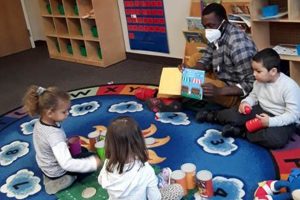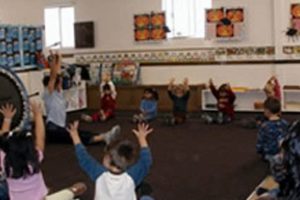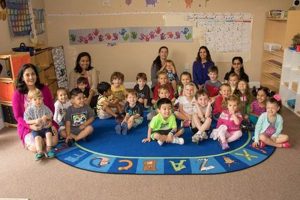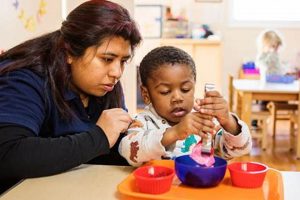Environments designed for early childhood education following the Montessori Method prioritize self-directed activity, hands-on learning, and collaborative play. These spaces typically feature child-sized furniture and a wide range of specially designed materials that encourage exploration and discovery across various curriculum areas, including practical life, sensorial, mathematics, language, culture, and science. A prepared environment of this type often includes dedicated areas for individual work, small group activities, and large group gatherings.
This educational approach fosters independence, concentration, and a love of learning. Developed by Dr. Maria Montessori, the method emphasizes the importance of allowing children to learn at their own pace and choose activities that spark their interest. This approach to early childhood education is known for its positive impact on children’s cognitive, social, and emotional development, laying a strong foundation for future academic success and lifelong learning.
This article will delve deeper into specific aspects of these prepared learning environments, exploring the core principles, materials, and practices that contribute to their effectiveness.
Tips for Creating Effective Montessori Learning Environments
The following tips offer guidance for establishing and maintaining spaces conducive to the Montessori philosophy:
Tip 1: Observe Children Carefully: Attentive observation of children’s interactions with the environment and materials is essential. This informs adjustments to the prepared environment, ensuring it remains relevant to their developmental needs and interests.
Tip 2: Emphasize Freedom within Limits: Children should be allowed to choose their activities and work independently, but within a structured and well-defined framework of established classroom routines and ground rules.
Tip 3: Maintain a Prepared Environment: The environment should be organized, aesthetically pleasing, and accessible. Materials should be logically arranged and readily available, encouraging children to select and return items independently.
Tip 4: Offer a Range of Activities: A variety of materials catering to different learning styles and developmental stages should be available, spanning practical life skills, sensorial exploration, language development, mathematics, and cultural studies.
Tip 5: Facilitate Independence: Activities should be designed to promote self-reliance. Materials should be self-correcting whenever possible, allowing children to recognize and rectify errors independently.
Tip 6: Encourage Social Interaction: While independent work is emphasized, opportunities for collaborative activities should also be provided, fostering social skills and cooperation.
Tip 7: Respect the Child’s Pace: Children learn at their own pace. Avoid rushing or interrupting their focused work. Allow ample time for exploration and mastery of concepts.
By implementing these strategies, one can cultivate a supportive and stimulating learning environment that empowers children to reach their full potential.
These practical tips offer valuable insights for educators and parents seeking to implement the Montessori Method effectively. This leads naturally to a concluding discussion on the long-term benefits observed in children who experience these carefully prepared environments.
1. Prepared Environment
The prepared environment forms the cornerstone of a Montessori preschool classroom. It is a thoughtfully designed space that fosters independence, self-directed learning, and a love of discovery in young children. More than just a physical space, it represents a carefully curated ecosystem where each element plays a vital role in the child’s development.
- Accessibility and Order:
Child-sized furniture and low, open shelves allow children to independently access materials. Organization is paramount, with materials arranged logically and aesthetically, promoting a sense of order and encouraging children to take responsibility for their learning environment. For example, materials for practical life activities, such as pouring and spooning, are often grouped together on a tray, readily available for a child to select and use.
- Sensory-Rich Materials:
Montessori materials engage multiple senses, appealing to children’s natural curiosity and encouraging exploration. Materials like textured fabrics, sound cylinders, and color tablets provide concrete experiences that aid in the development of sensory perception and cognitive skills. These hands-on experiences form the foundation for abstract learning later on.
- Freedom of Choice:
Within the structured environment, children have the freedom to choose activities that pique their interest. This autonomy fosters intrinsic motivation and allows children to learn at their own pace. Observing a child’s choices provides valuable insights into their developmental needs and interests, allowing educators to tailor guidance accordingly.
- Purposeful Activity:
Every material in a Montessori classroom has a specific educational purpose, designed to isolate a particular skill or concept. The materials are often self-correcting, allowing children to recognize and rectify errors independently, fostering self-reliance and problem-solving skills. For example, a puzzle with only one correct solution allows a child to immediately see if they have placed a piece incorrectly.
These interconnected elements of the prepared environment create a dynamic learning space where children actively engage with their surroundings, developing essential skills and a lifelong love of learning. The carefully curated environment becomes a silent teacher, guiding children towards independence, concentration, and a deeper understanding of the world around them.
2. Self-Directed Learning
Self-directed learning represents a cornerstone of the Montessori educational approach. Within the prepared environment of the Montessori preschool classroom, children are empowered to take ownership of their learning journey. This approach fosters intrinsic motivation, independence, and a deeper understanding of concepts through active exploration and discovery.
- Choice of Activity:
Children select activities based on their individual interests and developmental needs. This freedom of choice cultivates intrinsic motivation and a sense of ownership over the learning process. A child might choose to work with the pink tower one day and the movable alphabet the next, following their individual interests and learning pace.
- Independent Work:
Once a child selects an activity, they are encouraged to work independently, developing concentration and problem-solving skills. The teacher acts as a guide, offering support when needed but allowing the child to grapple with challenges and discover solutions on their own. This fosters self-reliance and a sense of accomplishment.
- Self-Correction:
Many Montessori materials are designed to be self-correcting, allowing children to identify and rectify errors independently. This built-in feedback mechanism promotes self-assessment and a deeper understanding of the concepts being explored. For instance, if a child is working with a knobbed cylinder block and attempts to place a cylinder in the wrong opening, they will immediately recognize the error and self-correct.
- Extended Concentration:
The uninterrupted work periods in a Montessori classroom allow children to develop sustained attention spans. Free from interruptions, children can fully immerse themselves in their chosen activities, leading to deeper engagement and mastery of skills. This focused work cultivates concentration, a valuable skill that extends beyond the classroom.
These interconnected elements of self-directed learning contribute significantly to the child’s overall development within the Montessori preschool classroom. By fostering independence, intrinsic motivation, and a love of learning, this approach prepares children not just for academic success, but also for lifelong learning and personal fulfillment. The emphasis on self-direction empowers children to become active participants in their education, shaping them into confident, capable, and self-reliant learners.
3. Hands-on Materials
Hands-on materials constitute a fundamental element of the Montessori preschool classroom. These meticulously designed materials play a crucial role in facilitating self-directed learning and fostering a deep understanding of abstract concepts through concrete experiences. The materials are carefully crafted to isolate specific skills and concepts, allowing children to focus on one aspect of learning at a time. This isolation of difficulty allows for progressive mastery, building a strong foundation for future learning.
The tactile nature of these materials engages children’s senses and encourages active exploration. Materials like the pink tower, sandpaper letters, and the golden beads provide concrete representations of abstract concepts such as size gradation, letter sounds, and the decimal system. For example, by manipulating the golden beads, children gain a tangible understanding of units, tens, hundreds, and thousands, making abstract mathematical concepts more accessible and comprehensible. The self-correcting nature of many Montessori materials allows children to identify and rectify errors independently, fostering self-reliance and a deeper understanding of the concepts being explored. A child working with the binomial cube, for instance, can visually perceive whether the pieces fit together correctly, allowing them to self-assess and refine their understanding of spatial relationships and algebraic concepts without direct teacher intervention.
The use of hands-on materials in Montessori classrooms contributes significantly to children’s cognitive, social, and emotional development. Through manipulation of these materials, children develop fine motor skills, problem-solving abilities, and a deeper understanding of the world around them. The emphasis on concrete experiences provides a solid foundation for abstract learning later on. Furthermore, the materials encourage collaboration and communication as children share discoveries and work together on projects, fostering social skills and a sense of community. The opportunity to choose and engage with materials independently fosters self-confidence, intrinsic motivation, and a lifelong love of learning. This approach empowers children to become active participants in their education, shaping them into confident, capable, and self-reliant learners.
4. Auto-education
Auto-education, the concept of self-directed learning, lies at the heart of the Montessori preschool classroom. It emphasizes the child’s innate drive to learn and discover, fostering independence and a deep understanding of concepts through active engagement with the environment and specially designed materials. This principle recognizes that children possess an inherent capacity to absorb knowledge from their surroundings and construct their understanding of the world. The prepared environment of the Montessori classroom facilitates this process by offering a rich array of sensory materials, each designed to isolate specific skills and concepts. For example, a child working with the sandpaper letters not only learns the shape and sound of each letter but also refines their fine motor skills and hand-eye coordination through tactile exploration. This active engagement leads to internalization of knowledge, unlike passive absorption of information through rote memorization.
The practical significance of auto-education lies in its impact on the child’s cognitive, social, and emotional development. By allowing children to choose activities that spark their interest and work at their own pace, auto-education fosters intrinsic motivation and a love of learning. The opportunity to explore materials independently and discover solutions through trial and error builds problem-solving skills and self-reliance. For instance, a child struggling to complete a puzzle develops perseverance and critical thinking skills as they experiment with different approaches, eventually experiencing the satisfaction of arriving at the solution independently. This fosters a sense of accomplishment and builds confidence in their ability to learn and overcome challenges. Furthermore, auto-education promotes self-discipline and concentration, essential skills for lifelong learning.
Auto-education, as a core principle of the Montessori approach, nurtures children’s natural curiosity and empowers them to become active participants in their educational journey. This approach cultivates not only academic skills but also essential life skills such as independence, problem-solving, and self-reliance, preparing children for success in school and beyond. By recognizing and fostering the child’s inherent drive to learn, Montessori education lays a strong foundation for lifelong learning and personal fulfillment.
5. Mixed-age classrooms
Mixed-age groupings form a distinctive characteristic of Montessori preschool classrooms, creating a dynamic learning environment that fosters social, emotional, and academic growth. This structure deviates from traditional, same-age classrooms and plays a crucial role in the overall Montessori philosophy. The interaction among children of different ages creates a unique social dynamic that benefits all involved.
- Leadership and Mentorship:
Older children often assume leadership roles, guiding and mentoring younger classmates. This provides opportunities to reinforce their own understanding of concepts while developing patience and empathy. Younger children benefit from the guidance of older peers, gaining access to more advanced skills and knowledge through observation and interaction. For example, an older child might demonstrate how to use a specific Montessori material to a younger peer, reinforcing their own understanding while providing valuable support.
- Collaboration and Socialization:
The mixed-age setting fosters a sense of community and encourages collaboration among children. Younger children learn to interact respectfully with older peers, while older children develop empathy and patience. Working together on projects or assisting each other with tasks promotes teamwork and communication skills. For instance, during a practical life activity like preparing a snack, older children might assist younger ones with tasks like pouring or spreading, fostering cooperation and a sense of shared responsibility.
- Natural Progression of Skills:
The mixed-age classroom provides a natural progression of skills and knowledge. Younger children observe and emulate older peers, inspiring them to reach for new challenges. Older children, in turn, are motivated to refine their understanding and skills to assist younger classmates. This creates a continuous cycle of learning and growth. A younger child might observe an older child working with the movable alphabet, sparking their interest in language and literacy activities.
- Prepared Environment Adaptation:
The prepared environment in a mixed-age Montessori classroom caters to a wider range of developmental stages. This diverse selection of materials and activities allows children to progress at their own pace, regardless of age. Older children can access more challenging materials while younger children can explore activities suited to their current developmental level. This ensures that all children are appropriately challenged and engaged in meaningful learning experiences. For instance, while some children might be working on basic addition with the golden beads, others might be exploring more complex multiplication operations with the stamp game, illustrating the adaptability of the environment to varying skill levels.
These interconnected facets of the mixed-age classroom create a dynamic and supportive learning environment that benefits all children. This structure fosters not only academic development but also essential social and emotional skills, preparing children for success in school and beyond. The mixed-age classroom exemplifies the Montessori philosophy’s emphasis on community, collaboration, and individualized learning, contributing significantly to the holistic development of each child.
6. Teacher as Guide
Within the Montessori preschool classroom, the teacher adopts a distinctive rolethat of a guide, rather than a traditional instructor. This shift in approach is fundamental to the Montessori philosophy, profoundly impacting the dynamics of the learning environment and the child’s developmental trajectory. Instead of directing learning through lectures or prescribed activities, the Montessori teacher prepares the environment and then carefully observes each child, identifying their individual needs, interests, and developmental stage. This observation informs subtle interventions, guiding children toward appropriate materials and activities that align with their readiness and learning style. The teacher acts as a facilitator, demonstrating the use of materials, offering gentle guidance, and fostering independence. For example, rather than explicitly teaching a concept like addition, the teacher might introduce the golden bead material and demonstrate its use, allowing the child to explore and discover the principles of addition through hands-on manipulation.
This approach fosters self-directed learning and encourages children to take ownership of their educational journey. The teacher’s role as a guide nurtures intrinsic motivation and allows children to learn at their own pace, respecting individual learning styles and developmental trajectories. This differs significantly from traditional classroom settings where the teacher typically dictates the pace and content of learning. The Montessori teacher empowers children to become active participants in their education, fostering critical thinking, problem-solving skills, and a lifelong love of learning. The teacher’s guidance extends beyond academic pursuits, encompassing social and emotional development. They model respectful communication, conflict resolution strategies, and grace and courtesy, creating a positive and supportive classroom community. Practical examples include facilitating group activities, mediating disagreements, and guiding children in practicing social graces. This holistic approach to development recognizes the interconnectedness of academic, social, and emotional growth.
The teacher’s role as a guide is essential to the successful implementation of the Montessori method. This approach empowers children to become independent, self-reliant learners, capable of pursuing their interests and achieving their full potential. By fostering intrinsic motivation, self-discipline, and a love of learning, the Montessori teacher plays a pivotal role in shaping children into confident, capable, and lifelong learners. This understanding of the teacher’s role is crucial for parents and educators considering or implementing the Montessori approach. It requires a shift in perspective from traditional teaching models, emphasizing observation, guidance, and the creation of a prepared environment that empowers children to take ownership of their learning. Challenges may include adapting to a less directive role and trusting the child’s innate drive to learn. However, the long-term benefits of fostering independence, self-reliance, and a love of learning make this approach a rewarding and impactful one.
7. Holistic Development
Holistic development, a core tenet of the Montessori philosophy, recognizes the interconnectedness of a child’s cognitive, social, emotional, and physical growth. Montessori preschool classrooms are intentionally designed to nurture this holistic development, fostering not only academic learning but also essential life skills. This approach recognizes that a child’s well-being and future success depend on the balanced development of all these interconnected facets.
- Cognitive Development:
Montessori materials and activities promote cognitive development through hands-on exploration and discovery. Materials like the pink tower and the knobbed cylinders encourage problem-solving, logical thinking, and spatial reasoning. The self-correcting nature of these materials fosters independent learning and critical thinking skills. For example, a child working with the binomial cube develops spatial reasoning and problem-solving skills through trial and error, leading to a deeper understanding of mathematical concepts without direct instruction.
- Social Development:
The mixed-age classroom structure and collaborative activities foster social development. Children learn to interact respectfully with peers of different ages, developing empathy, cooperation, and conflict-resolution skills. Practical life activities, such as setting the table or preparing a snack, provide opportunities for teamwork and shared responsibility. For instance, older children often mentor younger ones, demonstrating the use of materials or assisting with tasks, fostering a sense of community and mutual support.
- Emotional Development:
The Montessori environment supports emotional development by providing children with a sense of autonomy and control over their learning. The freedom to choose activities and work independently fosters self-confidence and self-reliance. The prepared environment provides a sense of order and predictability, promoting a feeling of security and well-being. Experiences of success through self-directed learning contribute to a positive self-image and a sense of accomplishment. For example, a child who successfully completes a challenging puzzle experiences a boost in self-esteem and confidence in their abilities.
- Physical Development:
Montessori classrooms provide opportunities for physical development through activities that refine fine and gross motor skills. Practical life activities, such as pouring, spooning, and buttoning, develop fine motor control. Movement within the classroom and outdoor play promote gross motor skills and coordination. For example, activities like walking on a line or carrying a tray develop balance and coordination. The use of child-sized furniture and tools ensures that children can comfortably and safely engage in physical activities that promote their development.
The Montessori preschool classroom fosters holistic development by providing a carefully prepared environment and a pedagogical approach that nurtures all aspects of the child’s growth. This integrated approach prepares children not only for academic success but also for lifelong learning, social responsibility, and personal fulfillment. By recognizing the interconnectedness of cognitive, social, emotional, and physical development, Montessori education provides a strong foundation for well-rounded individuals capable of thriving in a complex and ever-changing world.
Frequently Asked Questions
This section addresses common inquiries regarding Montessori preschool classrooms, providing clarity on the approach and dispelling common misconceptions.
Question 1: How does a Montessori classroom differ from a traditional preschool setting?
Montessori classrooms emphasize self-directed learning, hands-on materials, and mixed-age groupings, contrasting with the teacher-directed, often whole-group instruction found in traditional preschools. Children in Montessori environments choose their activities and work independently, while teachers act as guides rather than instructors. The prepared environment and specialized materials facilitate auto-education, fostering independence and a deeper understanding of concepts.
Question 2: What is the role of the teacher in a Montessori preschool classroom?
The teacher serves as a guide and observer, carefully preparing the environment and then facilitating children’s exploration and discovery. Rather than delivering direct instruction, the teacher introduces materials, offers support when needed, and observes children’s interactions to tailor guidance and support individual learning paths. This fosters independence and allows children to learn at their own pace.
Question 3: Are Montessori classrooms suitable for all children?
The Montessori approach benefits a wide range of learners, particularly those who thrive in environments that foster independence and self-directed exploration. While adaptable to various learning styles, it’s crucial to consider a child’s individual temperament and learning preferences when evaluating educational options. Open communication with Montessori educators can help determine suitability.
Question 4: Do children in Montessori programs learn the same skills as those in traditional preschools?
Montessori preschools address the same fundamental developmental areas as traditional preschools, including literacy, numeracy, social skills, and practical life skills. However, the approach to teaching these skills differs. Montessori education emphasizes hands-on learning and self-discovery, leading to a deep understanding of concepts. While the methods differ, the outcomes aim to prepare children for future academic success.
Question 5: Is the Montessori approach too unstructured for young children?
While Montessori classrooms offer freedom of choice, they are not unstructured. The prepared environment provides a framework with clear boundaries and expectations. Children choose their activities within this structured environment, developing self-discipline and time management skills. The teacher’s guidance and established routines ensure a balance between freedom and structure.
Question 6: How does the mixed-age classroom structure benefit children?
The mixed-age environment fosters peer learning, leadership opportunities, and a sense of community. Younger children learn from older peers, while older children reinforce their understanding by mentoring younger classmates. This dynamic creates a collaborative atmosphere and promotes social and emotional growth, mirroring real-world social dynamics.
Understanding these key aspects of Montessori education empowers parents to make informed decisions regarding their child’s early childhood education. Consulting with Montessori educators and visiting classrooms can provide further insights and clarity.
This FAQ section serves as a starting point for exploring the nuances of Montessori education. Further research and direct observation of Montessori environments can offer a deeper understanding of this unique educational approach.
Conclusion
Montessori preschool classrooms offer a distinctive approach to early childhood education, emphasizing self-directed learning, hands-on exploration, and holistic development. The prepared environment, characterized by carefully designed materials and a focus on freedom within structure, empowers children to learn at their own pace and cultivate a lifelong love of learning. Key elements, including auto-education, mixed-age groupings, and the teacher’s role as a guide, contribute to a dynamic learning experience that fosters independence, critical thinking, and social responsibility.
The potential of these thoughtfully designed environments to shape future generations warrants careful consideration and continued exploration. Further research into the long-term impacts of this educational approach can contribute valuable insights into optimizing early childhood education for individual and societal benefit. The focus on nurturing intrinsic motivation and a love of learning positions children for success not only in academic pursuits but also in navigating the complexities of a rapidly changing world.







